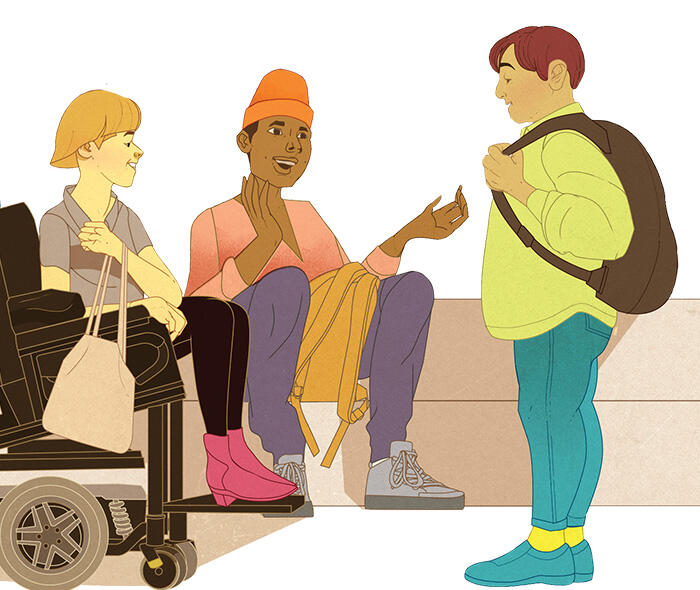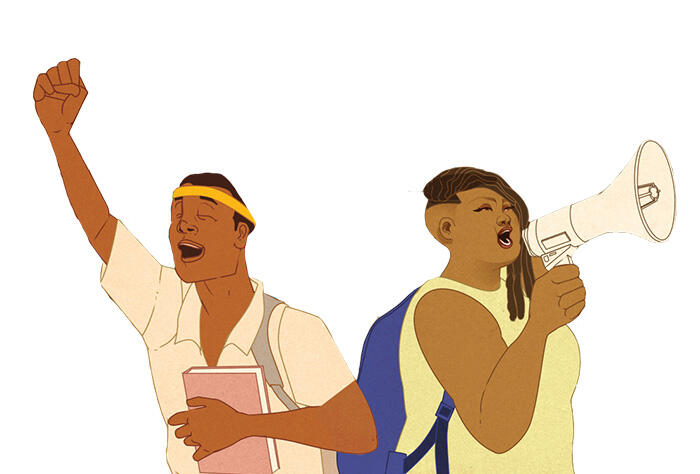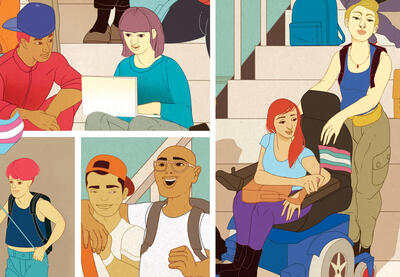Across the United States, and especially in the South, politicians intent on disenfranchising racially and culturally diverse communities and maintaining inequitable power structures have spent another legislative session pushing bills that censor teaching and curriculum and that ban students from playing sports based on their gender identity. From so-called “Don’t Say Gay” laws that erase LGBTQ+ identities in classroom discussions to bills that would force teachers to report transgender or LGBTQ+ students to unsupportive parents, we’re witnessing a devastating trend that spirals further each day.
Despite recent polling from the Public Religion Research Institute, Gallup and others that documents growing public support for LGBTQ+ rights, transgender people—especially transgender people of color—are being relentlessly attacked. Some politicians have leveraged this gap in support, which is rooted in the public’s lack of familiarity with transgender people, to build their profile and justify efforts to expand control over people’s access to health care, education and bodily autonomy. These legislations are backed by well-funded special interest groups with the intent to replicate them across the country. This anti-LGBTQ+ rhetoric—which has a long history in promoting discriminatory and dangerous policies and practices—significantly affects the lives and well-being of LGBTQ+ youth, particularly nonbinary and transgender youth.
After a grueling spring 2022 semester marked by political attacks on public education, students and educators are bracing for another long year of political exploitation.
The Movement for Inclusive School Communities
There have been great strides in equity and social justice in education over the years, from declining instances of homophobic insults, to increasing numbers of extracurricular resources like Gender and Sexuality Alliances (GSAs). Decades of research have established a strong foundation for education experts to understand and to build school communities that encourage each student to thrive. For instance, GSAs—LGBTQ+ student-led clubs—provide students a critical space to build a sense of belonging in their community and to learn leadership skills, and they provide a platform for students to engage with their school leaders and peers to advocate for their well-being. Over the last two decades, the rise in availability and acceptance of these clubs has helped contribute to supportive school climates, including declining rates of students hearing homophobic remarks in schools. Along with the presence of GSAs comes a growing network of local advocacy organizations devoted to LGBTQ+ students and the issues impacting the community. For instance, the GLSEN network now partners with GSA chapters in over 20 states.
Within classrooms, too, the very presence of LGBTQ+ topics can bolster students’ sense of safety and belonging. Research shows that students with access to inclusive curriculum and supportive teachers enjoy a more positive school climate where they feel safer in school and experience less harassment. It’s no exaggeration to say that school climate can be a life-or-death issue for young people grappling with social stigma, lack of access to resources and other challenges. The Trevor Project has found that LGBTQ+ youth who view their school as LGBTQ+-affirming report lower rates of attempting suicide.
Inclusive curriculum incorporates accurate lessons about historical events, figures and issues relevant to LGBTQ+ people and communities that have long been underrepresented in textbooks and other materials. Accurate and inclusive lessons not only affirm LGBTQ+ students, but also give non-LGBTQ+ students clear information about the diverse world around them and help prepare all young people to navigate and contribute to a multicultural society.
As one high school senior student leader shared when they first saw inclusive materials from a GSA advisor: “That history isn’t taught anywhere. Like, the guy who basically won World War II for us was a gay man. We never discussed that; nobody ever said his name. I never heard his name before. Even out of the mouth of my history teacher. And so it was like stuff like that, especially with my senior year, seeing sophomores and freshmen hearing about people just like them who did things in history. It was really cool; you can just kind of tell that they had never been able to identify with any historical figure before.”
But recent political efforts to disenfranchise and silence are erasing hard-won achievements, and LGBTQ+ young people are once again grappling with discrimination and harassment amid a wave of extremist backlash.

The Effects of Anti-LGBTQ+ Education Policies on Youth
LGBTQ+, Black, Indigenous and other youth of color have experienced physical violence and detrimental impacts to their mental health and academic performance because of these political developments. According to GLSEN’s 2019 national school climate survey, for instance, transgender students are far more likely to face harassment in school, with the vast majority of transgender students (84.4%) reporting they have felt unsafe in school because of their gender identity. We also know from GLSEN’s report on supporting students of color that 2 out of every 5 Black LGBTQ+ students experienced harassment or assault at school due to both their sexual orientation and their race, and nearly one third of Black LGBTQ+ students reported missing at least one day of school in the last month because they felt unsafe or uncomfortable.
Research from mental health experts has consistently shown that worrying about political attacks or harassment can exacerbate students’ anxiety and mental health issues. One Trevor Project survey revealed that over 90% of transgender and nonbinary youth are worried about being denied essential medical care or access to the school bathroom due to state or local laws. LGBTQ+ youth already experience some of the highest rates of depression and suicidal ideation among young people.
An LGBTQ+ high school student from Alabama—a member of GLSEN’s National Student Council—recently told BuzzFeed, “For me personally, this has been such a devastating moment. It’s just taking away my rights, my bodily autonomy. It’s making someone else choose what happens to my body, and I’m definitely not OK with that. I’m pretty scared, not just for Alabama, but for the entire country.”
It’s no coincidence that these political attacks look similar across the nation. As one of GLSEN’s chapter organizers in Kansas described, a recent anti-trans lawsuit over school policy was clearly, “a political stunt funded by a right-wing special interest group and doesn’t reflect the views of the vast majority of people in Kansas and across the country who support protections for LGBTQ+ people. Our leaders should be supporting school policies protecting and supporting transgender students, including policies to prevent educators from outing students.”

Educators and Youth Hold Firm to Advocating for Inclusive Schools
In confronting these anti-LGBTQ+ political attacks, students say they’re more committed to progress than ever, and many have redoubled their efforts to advocate for equality. These young advocates took time during summer break not only to recuperate, but to mobilize peers and members of their community for the next fight. For instance, GLSEN has received hundreds of recent inquiries from students eager to join a council of national student advocates.
“Accurate and inclusive lessons not only affirm LGBTQ+ students, but also give non-LGBTQ+ students clear information about the diverse world around them and help prepare all young people to navigate and contribute to a multicultural society.”
Educators and students will continue to lead the fight for inclusive education and fend off political attacks in their schools and states. Thousands of participants joined GLSEN’s most recent Day of Silence, a student-led nationwide protest against anti-LGBTQ+ erasure and discrimination where young people and allies demonstrated their support on social media or in school. Young people are calling for bolder investments from movement supporters and stronger commitments from elected leaders. Advocates say it’s a lack of political drive, not a lack of knowledge, that’s holding up progress. And research has shown that several key forms of support can help LGBTQ+ students thrive.
“Our research over the past two decades points to clear actions that schools can take to protect students who are facing anti-LGBTQ+ harassment and other forms of discrimination,” said Joseph Kosciw, Ph.D., director of GLSEN Research Institute. “It’s time for each and every school leader to understand the barriers that LGBTQ+ students face and to commit to making the changes necessary to protect all students, regardless of their sexual orientation, gender identity or gender expression.”
Two of these core supports, inclusive curriculum and the presence of supportive educators, have been particularly under fire in recent months as curriculum censorship bills have sought to erase LGBTQ+ history, topics and representation from classrooms. In addition to erasure, LGBTQ+ communities are facing dangerous stigma as politicians blatantly use the rhetoric of “protecting children” to accuse teachers and parents who support LGBTQ+ rights of pushing inappropriate sexual content on children.
The representation of LGBTQ+ people and issues in curriculum can make a world of difference for young people lacking support. And some efforts to shore up protections for LGBTQ+ equality and representation are already underway. GLSEN is equipping students and educators for their return to the new school year with a wide menu of resources. For instance, teachers and librarians can access free LGBTQ+ inclusive books through GLSEN’s Rainbow Library program or refer to guidelines for how to assess and build out lesson plans for talking about gender and sexuality. Students, too, can access resources that clarify their legal rights or get materials to prepare for days of action.
Meanwhile, at the federal level, the Department of Education recently released new Title IX guidance to expand protections for transgender and nonbinary youth. And President Joe Biden commemorated Pride Month this year with an Executive Order urging the Department of Education to defend LGBTQ+ youth amid a dangerous climate, with recommendations for a new working group devoted to LGBTQ+ students and families and for the expansion of the collection of data on sexual orientation and gender identity. GLSEN students and education experts are providing comments and calling on their congressional representatives to advance new legislation as well, including the Safe Schools Improvement Act, LGBTQI+ and Women’s History Education Act and LGBTQI+ Data Inclusion Act.
Whether these or future inclusive policies are enacted or enforced at the state level will depend largely on the outcomes of fall elections and the political climate when federal and state legislative sessions ramp up again.
Meanwhile, LGBTQ+ youth and allies across the country will remain resilient and continue fighting for the justice that we all deserve.
Resources
GLSEN’s Four Key Supports
GLSEN research has identified four major supports that schools can use to cultivate a safe and supportive environment for all students: supportive educators, comprehensive policies, inclusive curriculum and GSAs.
Supporting LGBTQ+ Youth of Color
Erasure and Resilience: The Experiences of LGBTQ Students of Color is a series of four research reports that examines the school experiences of Asian American and Pacific Islander (AAPI), Black, Latinx, and Native and Indigenous LGBTQ youth.
GLSEN Navigator and Map Resources
State laws around the nation provide varied degrees of support and protection for LGBTQ+ youth. GLSEN’s maps are designed to give communities knowledge about the political environment, student experiences and tools for advocating for positive school change that benefits all young people.
Best Practices for Serving LGBTQ Students
This guide helps educators and school leaders make curriculum and policy decisions that include LGBTQ students and prepare all students to thrive in a diverse democracy. And the webinar models how to create an inclusive classroom culture and build an intersectional curriculum that incorporates queer history and perspectives.
Queer America
From Learning for Justice and hosts Leila Rupp and John D’Emilio, Queer America takes listeners on a journey that spans from Harlem to the Frontier West, revealing stories of LGBTQ life. This 13-episode podcast is produced in partnership with University of Wisconsin Press, publishers of Understanding and Teaching U.S. Lesbian, Gay, Bisexual, and Transgender History—the first book designed for high school and university teachers who want to integrate LGBTQ history into their standard curriculum.
Gender-affirming Care: What It Is and Why It's Necessary
By Dorothee Benz, Ph.D.
They Didn't Back Down
By Cory Collins
Teaching Stonewall
By Cory Collins
Being There for Nonbinary Youth
By Jey Ehrenhalt
Caroline Is a Boy
By Dana Williams
